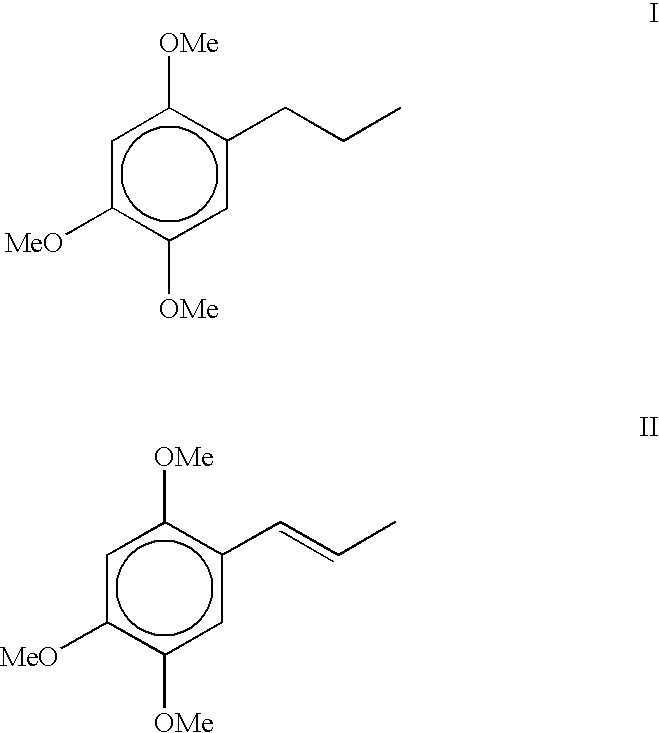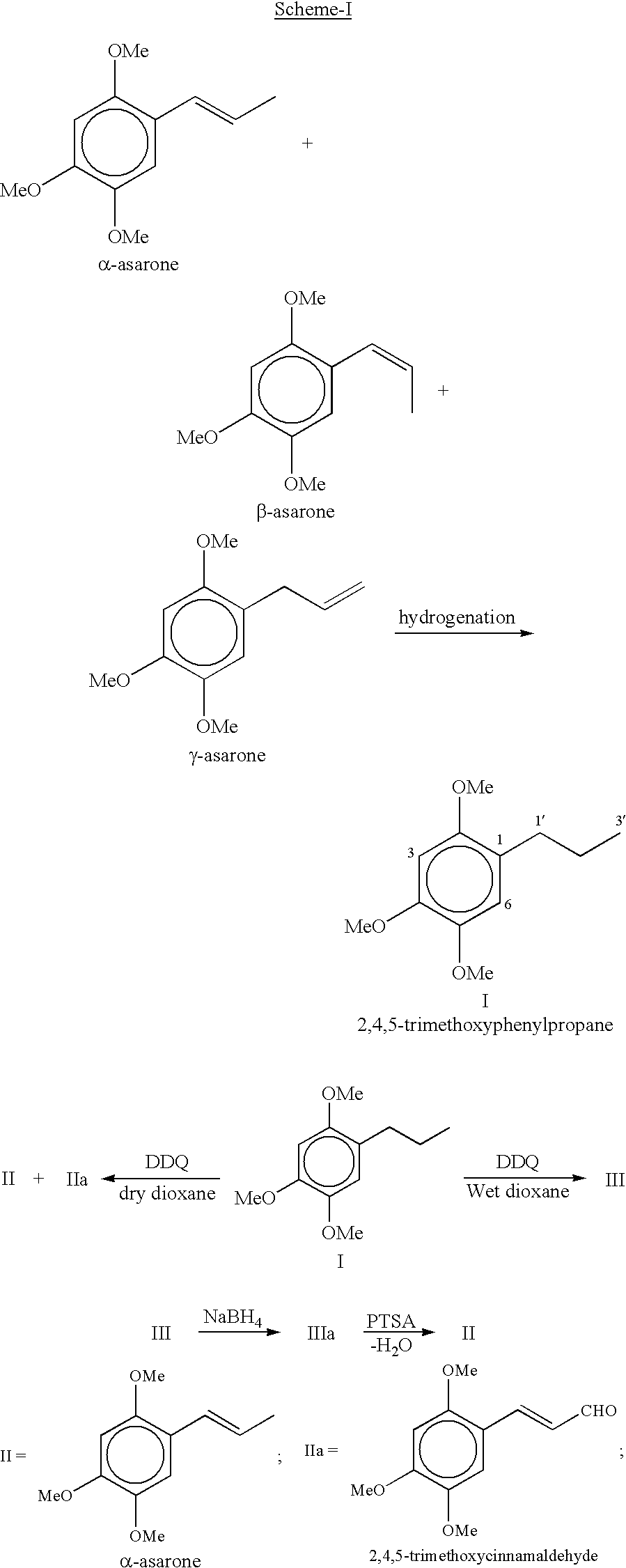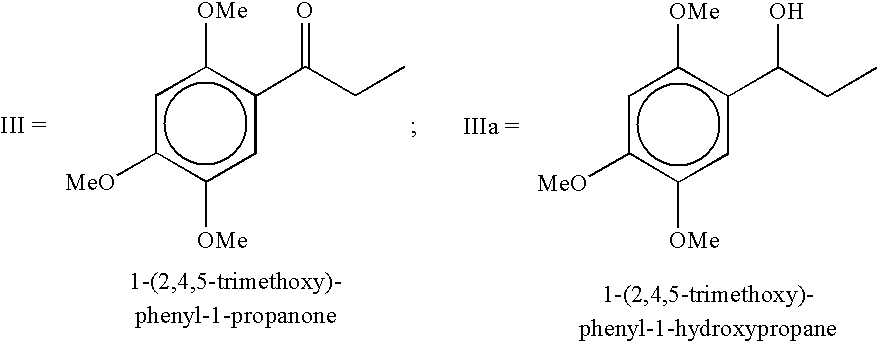Process for the preparation of pharmacologically active alpha-asarone from toxic beta-asarone rich acorus calamus oil
a technology of acorus calamus and a process for preparing acorus calamus oil, which is applied in the preparation of carbonyl compounds, oxygen-containing compounds, organic chemistry, etc., can solve the problems of difficult separation of less abundant alpha-asarone, large variability in quality of calamus oil, and the international ban on calamus oil of asian origin for any kind of use in flavor, perfumery and pharmaceutical industries, etc., to enhance the profitable use of alpha-
- Summary
- Abstract
- Description
- Claims
- Application Information
AI Technical Summary
Benefits of technology
Problems solved by technology
Method used
Image
Examples
example 1
Preparation 2,4,5-trimethoxyphenylpropane (dihydro asarone): The starting material 2,4,5-trimethoxyphenylpropane is prepared by hydrogenation of .beta.-asarone (isolated from Acorus calamus oil) or of commercially available calamus oil rich in asarones (i.e. .beta. and / or .alpha.,.gamma.-asarone) content.
(a) Hydrogenation of .beta.-asarone into 2,4,5-trimethoxyphenylpropane (dihydro asarone):
.beta.-asarone was isolated by loading the crude calamus oil (17.00 g) on silica gel column and then eluted the column with hexane to remove unwanted non-polar compounds. Subsequent elution with hexane-ethylacetate mixture with increasing proportion of ethylacetate upto 10% gave 13.94 g (82%, w / w) of pure liquid; R.sub.f 0.63 (hexane:toluene:ethylacetate=1:1:0.1); .sup.1 H NMR (CDCl.sub.3, 300 MHz) .delta. 6.84 (1H, s, H-6), 6.53 g(1H, s, H-3), 6.50 (1H, dd, J=15.8 Hz and 1.5 Hz, H-1'), 5.78 (1H, dq, J=6.5 Hz and 15.8 Hz, H-2'), 3.88, 3.83 and 3.79 (s, 3H, each, 3-OCH.sub.3) and 1.85 (3H, dd, J=...
example ii
Preparation of .alpha.-asarone (trans-2,4,5-Trimethoxyphenylpropene) via dehydrogenation of 2,4,5-trimethoxyphenylpropane with DDQ: A solution of DDQ (2.04-2.65 g) in anhydrous dioxane (40 mL) was added dropwise over a period of 10-15 min to a ice cold and well stirred solution of 2,4,5-trimethoxyphenylpropane (1.89 g, 0.009 mol) in anhydrous dioxane (55 mL) and stirring was continued at room temperature for over night under inert atmosphere. The precipitated solid (DDQH.sub.2) was filtetred and further washed twice with dioxane. The combined dioxane was evaporated and concentrate was poured into water and then extracted with dichloromethane (3.times.70 mL). The combined organic layers were washed with brine (3.times.15 mL), 10% sodium bicarbonate (2.times.10 mL), brine (3.times.15 mL) and dried over anhydrous sodium sulphate. The residue obtained on evaporation of the solvents was chromatographed on silica gel column using hexane-ethyl acetate mixture with increasing proportion of ...
example iii
Preparation of .alpha.-asarone via dehydrogenation of 2,4,5-trimethoxyphenylpropane with DDQ containing little amount of silica gel: Addition of a catalytic amount of silica gel (0.2-0.6 g) drastically accelerated the rate of reaction as well as improved the yield of .alpha.-asarone when above dehydrogenation process (Example II-a) was conducted under the same condition resulting .alpha.-asarone in 72% yield and trans-2,4,5-trimethoxycinnamaldehyde in 18% yield.
PUM
| Property | Measurement | Unit |
|---|---|---|
| pressure | aaaaa | aaaaa |
| temperature | aaaaa | aaaaa |
| molar ratio | aaaaa | aaaaa |
Abstract
Description
Claims
Application Information
 Login to View More
Login to View More - R&D
- Intellectual Property
- Life Sciences
- Materials
- Tech Scout
- Unparalleled Data Quality
- Higher Quality Content
- 60% Fewer Hallucinations
Browse by: Latest US Patents, China's latest patents, Technical Efficacy Thesaurus, Application Domain, Technology Topic, Popular Technical Reports.
© 2025 PatSnap. All rights reserved.Legal|Privacy policy|Modern Slavery Act Transparency Statement|Sitemap|About US| Contact US: help@patsnap.com



